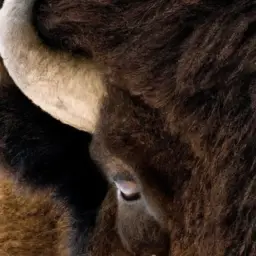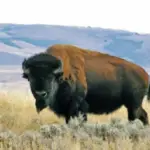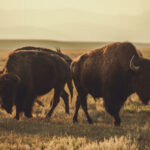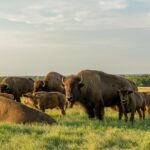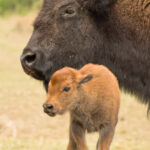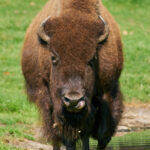Imagine a moment of curiosity where you find yourself pondering the weight of a bison head. It’s a strange thought, but one that has captured the attention of many. To satisfy your curiosity, “How Much Does A Bison Head Weigh” is here to provide you with the answer you seek. This product offers an intriguing exploration into the weight of a bison head, presenting you with fascinating facts and figures that will leave you in awe. Uncover the surprising weight of these majestic creatures and gain a deeper understanding of their incredible anatomy. Join us on this captivating journey as we unveil the weight of a bison head and the mysteries it holds.
Understanding the Bison Species
Classification and Characteristics of Bison
Bison, scientifically known as Bison bison, are large, herbivorous mammals belonging to the Bovidae family. They are closely related to domestic cattle and are commonly found in various regions of North America and Europe. These majestic creatures are known for their robust build, shaggy fur, and iconic horns.
Bison in North America vs Europe
While bison can be found in both North America and Europe, there are slight differences between the two populations. The North American bison, often referred to as the American bison or buffalo, is the heaviest land animal in North America. On the other hand, the European bison, also known as the wisent, is slightly smaller in size and considered a vulnerable species due to its declining population.
Bison and their Natural Habitat
Bison prefer open grasslands and prairies as their natural habitat. They have the ability to adapt to various environmental conditions, including both temperate and cold climates. Bison are highly adaptable grazers, and their diet consists mainly of grasses, sedges, and other vegetation. They play a crucial role in maintaining the ecological balance of their habitat by influencing plant growth through their grazing patterns.
Anatomy of a Bison
Physical Attributes of a Bison
Bison are characterized by their large, robust bodies covered in dense fur. Adult males, known as bulls, can reach a shoulder height of 5 to 6.5 feet (1.5 to 2 meters) and weigh between 1,800 and 2,800 pounds (800 to 1,270 kilograms). Adult females, called cows, are slightly smaller, with a shoulder height ranging from 4 to 5 feet (1.2 to 1.5 meters) and a weight of 900 to 1,200 pounds (410 to 540 kilograms).
Unique Features of a Bison Head
The head of a bison is one of its most distinctive features. It is adorned with a massive pair of curved horns, which can grow up to 2 feet (60 centimeters) long. These horns are made up of a bony core covered with a keratin sheath, giving them their strength and shape. The head also houses the bison’s sensory organs, including its eyes, ears, and nostrils, which are crucial for detecting predators and foraging for food.
The Size of a Bison Body Compared to its Head
In comparison to the overall size of its body, a bison’s head is relatively small. While the body of a bison is massive and muscular, the head appears more compact. This is due to the impressive size and weight of the bison’s body, which distributes its mass more evenly throughout its frame. The smaller head size allows for a more streamlined shape, making it easier for the bison to move through its environment.
How Much Does A Bison Head Weigh
Average Weight of a Bison Head
The weight of a bison’s head can vary depending on its age, sex, and overall size. On average, an adult bison’s head can weigh anywhere between 50 to 75 pounds (23 to 34 kilograms). This weight primarily consists of the skull, horns, and associated musculature.
Factors Affecting the Weight of a Bison Head
Several factors can influence the weight of a bison’s head. One significant factor is the age of the bison. As bison age, their heads tend to grow larger and heavier. Additionally, the sex of the bison plays a role, as male bison generally have larger and heavier heads than females. Genetic factors, such as individual variation within the species, can also contribute to differences in head weight.
Comparison with Other Animals
When comparing the weight of a bison’s head to other animals, it is important to note that bison are among the largest terrestrial mammals. Their heads are significantly heavier than those of most other animals in their ecosystems, including deer, elk, and even domestic cattle.
Difference in Weight Between Male and Female Bison Heads
Bison Sexual Dimorphism
Male and female bison exhibit sexual dimorphism, which means that there are noticeable differences in physical characteristics between the two sexes. In the case of bison, this dimorphism is particularly evident in the size and weight of their heads. Male bison, known as bulls, have larger and heavier heads compared to the female bison, or cows.
Weight of Adult Male Bison Head
The head of an adult male bison, or bull, can weigh approximately 60 to 75 pounds (27 to 34 kilograms). This added weight is primarily due to their larger horns, which are used for combat during the mating season. The extra musculature required to support these formidable horns also contributes to the overall weight of the male bison’s head.
Weight of Adult Female Bison Head
In contrast, the head of an adult female bison, or cow, weighs slightly less than that of a male. On average, the head of an adult female bison can weigh around 50 to 65 pounds (23 to 30 kilograms). While still substantial in size, the female bison’s head is comparatively lighter, reflecting the differences in necessary physiological adaptations between the sexes.
Weight of Bison Head at Different Stages of Life
Weight of Bison Calf’s Head at Birth
A newborn bison calf has a relatively small and lightweight head compared to the adults. At birth, a bison calf’s head usually weighs around 8 to 15 pounds (4 to 7 kilograms). This lighter head allows for easier mobility and growth, enabling the calf to navigate its new surroundings more efficiently.
Head Weight Growth Rate for Bison
As bison grow and develop, their heads naturally increase in weight. The growth rate of a bison’s head is influenced by various factors, such as genetics, diet, and overall health. On average, a bison’s head will continue to grow until it reaches its full size by the time it reaches adulthood, typically around the age of three to five years.
Impact of Maturity on Bison Head Weight
As bison reach maturity, the weight of their heads becomes more substantial. This increase in weight is primarily due to the growth of the bison’s horns and associated musculature. By the time they reach adulthood, both male and female bison have developed larger and heavier heads, allowing them to fulfill their roles in daily life, including combat, feeding, and mating rituals.
The Role of Bison Head in Its Daily Life
Use of Bison’s Head for Combat
The head of a bison is crucial for combat, especially during the mating season when males engage in intense battles to establish dominance and win the opportunity to mate with females. The weight and strength of the bison’s head, along with its formidable horns, play a vital role in these confrontations, as bison bulls lock heads and push against each other to determine the dominant male.
Importance of Bison’s Head for Feeding
The head of a bison is well-adapted for feeding on grasses and other vegetation, which make up a significant portion of their diet. Bison use their large heads to graze on grasslands and prairies, utilizing their strong neck muscles to lower their heads and rip out mouthfuls of vegetation. The heavy weight of their heads helps provide the necessary strength to forage for food efficiently.
The Significance of Bison’s Head Size in Mating Rituals
During the breeding season, the size and weight of a male bison’s head become particularly important for establishing dominance and attracting female mates. The larger and more impressive the head, including the size and shape of the horns, the more likely a bull is to win battles against other males and secure breeding opportunities. The size of the bison’s head is a visual display of strength and genetic fitness, making it a crucial aspect of the mating rituals within the species.
The Impact of Bison Head Weight on its Movement and Behavior
How Bison Head Weight Influences Mobility
The weight of a bison’s head, though relatively heavy, does not significantly impact its mobility. The bison’s body, with its strong muscular structure, is well-equipped to support the weight of the head while allowing for swift movements across its natural habitat. The distribution of weight throughout the massive body of a bison helps maintain balance and agility, allowing it to navigate a variety of terrains with ease.
The Effect of Head Weight on Hunting and Food Gathering Behaviors
The weight of a bison’s head does not directly influence its hunting behavior as bison are herbivorous animals and primarily graze on vegetation. However, the powerful neck muscles required to support the heavy head contribute to their ability to rip vegetation from the ground and consume vast quantities of grasses and other plants. The weight of the head plays a role in the efficiency of their feeding behavior, allowing them to sustain their large bodies on a herbivorous diet.
Bison Head Weight and Social Behavior
The weight and size of a bison’s head play a significant role in their social behavior, particularly during dominance competitions and mating rituals. A bull with a larger and heavier head is more likely to establish its dominance over other males, ensuring its place as the primary mating partner. The weight of the head conveys strength and genetic fitness, making it an essential characteristic for intra-species communication and social hierarchy.
The Impact of Diet on Bison Head Weight
Role of Nutrition in Bison’s Head Weight
A bison’s diet plays a crucial role in determining the weight of its head. Adequate nutrition is essential for proper growth and development, including the growth of the head and horns. A diet rich in nutrient-dense plants provides the necessary building blocks for bone and muscle development, contributing to the overall weight and robustness of the bison’s head.
Impact of Seasonal Changes on Bison’s Diet and Head Weight
Seasonal changes in the availability of food can influence the weight of a bison’s head. During the warmer months, when grasses and other vegetation are abundant, bison have access to a more nutrient-rich diet. This abundance of food can lead to increased head weight as they consume more to support their growth. In contrast, during winter months when food may be scarce, the bison’s head weight may remain relatively stable or even decrease slightly as their diet is less plentiful.
Link Between Habitat and Availability of Diet to Head Weight
The habitat in which bison reside can directly impact the availability of their diet, subsequently affecting their head weight. Different regions may offer varying levels of food resources, which can influence the overall size and weight of a bison’s head. Areas with plentiful grasslands and prairies provide an abundant food supply, contributing to larger, heavier heads. In contrast, regions with less productive vegetation may result in smaller, lighter heads as bison have limited access to nutrient-dense forage.
Preservation and Display of Bison Heads
Methods of Preserving Bison Heads
Bison heads can be preserved through various methods, including taxidermy and skeletal articulation. In taxidermy, the bison head is carefully prepared, preserving the skin, fur, and facial features to create a lifelike representation of the animal. Alternatively, skeletal articulation involves assembling the cleaned bones of the bison’s head into a natural and anatomically correct form to showcase its structure and unique characteristics.
Weight Changes During the Preservation Process
During the preservation process, the weight of a bison’s head may undergo slight changes. Taxidermy usually involves removing excess tissue and treating the head with preservation chemicals, which can cause some weight loss. Similarly, the cleaning and bleaching process in skeletal articulation may also result in a minor reduction in weight due to the removal of tissue and the transformation of organic material.
Popular Uses of Preserved Bison Heads
Preserved bison heads serve various purposes, including educational displays, museum exhibits, and decorative pieces. Their majestic appearance and unique features make them popular among collectors and wildlife enthusiasts alike. Bison heads also hold cultural and historical significance in many indigenous communities, symbolizing strength, resilience, and the connection to the natural world.
What is the Average Weight of a Bison’s Head Compared to the Total Population of Bison in the US?
The average weight of a bison’s head is around 200-300 pounds, while the current number of bison population in United States is estimated to be around 500,000. Considering the average weight of a bison’s head, this indicates a considerable weight collectively across the entire bison population in United States.
Conservation Status of Bison
Current Bison Population and Threats
The bison population has faced significant challenges throughout history, including overhunting, habitat loss, and disease. However, due to conservation efforts, the North American bison population has rebounded to an estimated 400,000 individuals in managed herds and protected areas. The European bison, due to its smaller population size and limited distribution, remains classified as a vulnerable species.
Importance of Bison Conservation
Bison conservation is crucial for preserving the ecological balance of their habitats. As keystone species, bison play a vital role in shaping the grassland ecosystems through their grazing patterns. Their presence helps maintain biodiversity by creating diverse habitats for other species, including birds, small mammals, and insects. Furthermore, bison hold cultural and historical significance, representing the natural heritage of North America and Europe.
Conservation Efforts and Future of Bison
Efforts are underway to protect and restore bison populations across their range. Conservation organizations, government agencies, and indigenous communities collaborate to establish protected areas and promote sustainable management practices. These initiatives aim to ensure the long-term viability of bison populations, protect their natural habitats, and raise awareness about their ecological and cultural importance. By working collectively, future generations can continue to witness the majesty and grandeur of these magnificent animals for years to come.

